|
Modelers,
particularly those just getting into or returning to the hobby, are often forced
to apportion their dollars, pounds, marks or yen between the kits they covet and
the references they require. Of course, keep in mind that nothing is truly “required.”
You can build a kit right out of the box if you wish, relying only on the instructions
and box art work as your guide. But
many of these kits, especially those designed and molded before the early 1990s,
are often lacking in smaller details. There may be inaccuracies because the models
are based on prototypes that were changed before production, or never went into
production (Tamiya’s M3A2 Halftrack, for example) or salvaged vehicles containing
alterations made during or after the war. Some of the old Tamiya tanks from the
1970s were motorized, and compromises were made in the hull dimensions in order
to accommodate motors and batteries. Many
modelers, as they seek to challenge their skills (and patience!) will track down
references and even copies of old Army technical manuals to determine what’s
wrong in a kit and how they might make it more accurate. This may require scratchbuilding
parts, or buying additional “after market” sets of resin pieces or photoetched
brass or steel. This drive for accuracy can be as confounding as it is rewarding,
resulting in a condition we refer to a “Advanced Modeler’s Syndrome”
or AMS. It’s also generally expected that modelers who wish to enter their
work in competition will make efforts to improve upon the kit, beyond just building
and painting it “out of the box” (OOTB). Ultimately,
it’s important to remember it’s up to you how you wish to build your
model, and what gives you enjoyment. I’ve
acquired a hefty number of books over the years, and I’ve summarized the
best of them below. Many of these can be found in your public library, or obtained
through interlibrary loan. At some point you’ll probably want to own a few
of these for yourself. Initial publication prices are in U.S. dollars, and are
provided as a relative guide. MODELING
FEATURES
Large Scale Armor Modeling: Building a 1/6 Scale Stuart Tank, by Robert N. Steinbrunn, Schiffer Publishing, Ltd., 2011, ISBN 978-0-7643-3953-0 ($45)
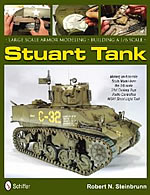 I've been fortunate to see this impressive tank in person. Fellow Minnesota resident Bob Steinbrunn brought it to a meeting of the Minnesota Military Figure Society and again to our Boots and Treads II show in the spring of 2011. It's an incredible piece of work, taking a 21st Century Toys M5A1 Stuart and turning it into a remote-controlled museum piece. Bob began by stripping the tank apart and then comparing the parts to their historical counterparts. He ended up reconditioning or replacing most of the components, which naturally involved extensive research as well as cutting, drilling, grinding, laminating, scrounging, adapting, vacuforming, wiring, casting, and painting. He documented every step of the way, and this book is a complete account of in text and multitude of photos. Bob provides all of the details so that if one wanted to take on this epitome of Advanced Modeler's Syndrome, he would find this to be a handy instruction manual (Bob even put foundry casting marks an accessory M2 tripod for the .30 Browning machine gun). Even if you stay within the modest confines of 1/35, this book will help you trick out the AFV Club Stuart. The 168-page book (provided to me by the publisher for review) includes a bibliography of the modeler's references and resources. This is the book to set out on the coffee table when company comes over. I've been fortunate to see this impressive tank in person. Fellow Minnesota resident Bob Steinbrunn brought it to a meeting of the Minnesota Military Figure Society and again to our Boots and Treads II show in the spring of 2011. It's an incredible piece of work, taking a 21st Century Toys M5A1 Stuart and turning it into a remote-controlled museum piece. Bob began by stripping the tank apart and then comparing the parts to their historical counterparts. He ended up reconditioning or replacing most of the components, which naturally involved extensive research as well as cutting, drilling, grinding, laminating, scrounging, adapting, vacuforming, wiring, casting, and painting. He documented every step of the way, and this book is a complete account of in text and multitude of photos. Bob provides all of the details so that if one wanted to take on this epitome of Advanced Modeler's Syndrome, he would find this to be a handy instruction manual (Bob even put foundry casting marks an accessory M2 tripod for the .30 Browning machine gun). Even if you stay within the modest confines of 1/35, this book will help you trick out the AFV Club Stuart. The 168-page book (provided to me by the publisher for review) includes a bibliography of the modeler's references and resources. This is the book to set out on the coffee table when company comes over.
Modeling
U.S. Armor of World War 2,
by Steven J. Zaloga, Osprey Publishing, Inc., 2009, ISBN 978-1-84603-772-6 ($40)
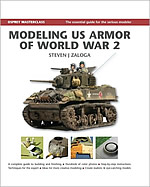 Unlike
Zaloga's other project-oriented books below, this convenient spiral-bound tome
is a comprehensive master class in armor modeling, drawing upon an array of U.S.
armor he's built over the past two decades. Like his predecessors Shep Paine and
Tony Greenland in this approach, Zaloga provides countless tips and helpful illustrations
to walk the reader through building and improving models. From kit construction,
detailing, painting and weathering through building a base and photographing the
finished project, "The Zaloga Way" is clearly presented and will engage
beginners and advanced modelers alike. In fact, if you're fairly new to modeling
and know you want to build a range of American WWII armor, I'd recommend this
book above any other model construction books as a first purchase. Then, if you
want to go deeper into Shermans, Stuarts, and tank destroyers, you may benefit
from the books below. (Perhaps we'll see a book on building jeeps someday??) Unlike
Zaloga's other project-oriented books below, this convenient spiral-bound tome
is a comprehensive master class in armor modeling, drawing upon an array of U.S.
armor he's built over the past two decades. Like his predecessors Shep Paine and
Tony Greenland in this approach, Zaloga provides countless tips and helpful illustrations
to walk the reader through building and improving models. From kit construction,
detailing, painting and weathering through building a base and photographing the
finished project, "The Zaloga Way" is clearly presented and will engage
beginners and advanced modelers alike. In fact, if you're fairly new to modeling
and know you want to build a range of American WWII armor, I'd recommend this
book above any other model construction books as a first purchase. Then, if you
want to go deeper into Shermans, Stuarts, and tank destroyers, you may benefit
from the books below. (Perhaps we'll see a book on building jeeps someday??)
Modelling
the M3/M5 Stuart Light Tank, by Steven
J. Zaloga, Osprey Publishing, Inc., 2003, ISBN 1-84176-763-8 ($19).
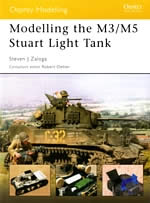 These
little light tanks were employed by all the major allies during WWII, and with
the release of M3 variants from AFV Club and Academy to complement (if not fully
supersede) Tamiya's weak M3, truncated M5A1, and creaky M8 howitzer, this book
should have wide appeal. Zaloga gives a brief overview of available light tanks
before building AFV Club's M3A3 under the French flag. This build is more out-of-the-box,
with an emphasis on painting and weathering for a Paris liberation setting. An
advanced project combines Tamiya's M3 and Academy's M3A1 kits to offer a Russian
version from 1943. This includes some reworking of the rear hull and engine grill.
We get to the Americans in a few different workings of Tamiya's M5A1, with much
more extensive corrections to the kit's too-short upper and lower hull. In the
final section, Zaloga gives some good instructions for a British M3 Honey in Northern
Africa, a Philippines M3 in 1941, a U.S. M3A1 and M5 in Tunisia, a Yugoslav M3A3
hull with a PaK 40 gun mounted in place of the turret, and a quick review of his
M8 howitzer motor carriage initially published in Military Modelling. The book
concludes with a color chart that includes "normal," "scale,"
and "faded" olive drab paints, as well as British paint colors (presumably
"normal" as the other gradients are not offered). As with all of Zaloga's
work, any AFV modeler should find ample inspiration and a good education in this
book. These
little light tanks were employed by all the major allies during WWII, and with
the release of M3 variants from AFV Club and Academy to complement (if not fully
supersede) Tamiya's weak M3, truncated M5A1, and creaky M8 howitzer, this book
should have wide appeal. Zaloga gives a brief overview of available light tanks
before building AFV Club's M3A3 under the French flag. This build is more out-of-the-box,
with an emphasis on painting and weathering for a Paris liberation setting. An
advanced project combines Tamiya's M3 and Academy's M3A1 kits to offer a Russian
version from 1943. This includes some reworking of the rear hull and engine grill.
We get to the Americans in a few different workings of Tamiya's M5A1, with much
more extensive corrections to the kit's too-short upper and lower hull. In the
final section, Zaloga gives some good instructions for a British M3 Honey in Northern
Africa, a Philippines M3 in 1941, a U.S. M3A1 and M5 in Tunisia, a Yugoslav M3A3
hull with a PaK 40 gun mounted in place of the turret, and a quick review of his
M8 howitzer motor carriage initially published in Military Modelling. The book
concludes with a color chart that includes "normal," "scale,"
and "faded" olive drab paints, as well as British paint colors (presumably
"normal" as the other gradients are not offered). As with all of Zaloga's
work, any AFV modeler should find ample inspiration and a good education in this
book.
Modelling
U.S. Army M4 (75mm) Sherman Medium Tank,
by Steven J. Zaloga, Osprey Publishing, Inc., 2006, ISBN 10-84176-965-7 ($19). 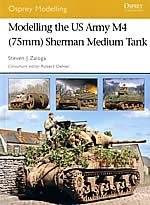 Zaloga
does it again. This time, he walks us down Sherman memory lane with notable kits,
beginning with the workhorse M4A3 kit from Tamiya in 1981 up through the company's
recent 1/48 offerings, with visits to Italeri and DML along the way. Then he gets
into the meat of the book. The first of four featured projects is an early M4A1
from Operation Husky in Sicily, using a combination of Formations, DML, Tamiya,
and Tasca parts and RHPS tracks. Very helpfully, Zaloga provides a pattern for
the distinctive mushroom-topped wading stack used on these invasion tanks. The
next project is more advanced, correcting some upper hull deficiencies in Tamiya's
M4 and adding other aftermarket pieces and Warriors figures to portray the familiar
photo of a crew from the 8th Tank Battalion, 4th Armored Division, blasting away
with the .50 atop the tank heavily festooned with camo foliage. This projects
gets a pretty detailed interior beneath all the shrubbery. If you like mine rollers
in 1/48 scale, the following project uses Tamiya's quarter-scale M4 and Gasoline's
T1E3 mixed media mine-roller set. Zaloga provides a few tech manual illustrations
to help navigate the construction. Our final Sherman is a Dragon M4A3(76mm)W hosting
Italeri's high-bustle turret and a lot of epoxy putty for some heavy-duty glacis
sandbagging and dowel logs hung from the hull sides. The tank is then wrapped
with camo netting and topped with some scale pine boughs. Throughout the book
the writing is clear and the photos are helpful and inspiring. The book concludes
with a color chart and list of references—including a citation for the "handy
site" you are now visiting. Zaloga
does it again. This time, he walks us down Sherman memory lane with notable kits,
beginning with the workhorse M4A3 kit from Tamiya in 1981 up through the company's
recent 1/48 offerings, with visits to Italeri and DML along the way. Then he gets
into the meat of the book. The first of four featured projects is an early M4A1
from Operation Husky in Sicily, using a combination of Formations, DML, Tamiya,
and Tasca parts and RHPS tracks. Very helpfully, Zaloga provides a pattern for
the distinctive mushroom-topped wading stack used on these invasion tanks. The
next project is more advanced, correcting some upper hull deficiencies in Tamiya's
M4 and adding other aftermarket pieces and Warriors figures to portray the familiar
photo of a crew from the 8th Tank Battalion, 4th Armored Division, blasting away
with the .50 atop the tank heavily festooned with camo foliage. This projects
gets a pretty detailed interior beneath all the shrubbery. If you like mine rollers
in 1/48 scale, the following project uses Tamiya's quarter-scale M4 and Gasoline's
T1E3 mixed media mine-roller set. Zaloga provides a few tech manual illustrations
to help navigate the construction. Our final Sherman is a Dragon M4A3(76mm)W hosting
Italeri's high-bustle turret and a lot of epoxy putty for some heavy-duty glacis
sandbagging and dowel logs hung from the hull sides. The tank is then wrapped
with camo netting and topped with some scale pine boughs. Throughout the book
the writing is clear and the photos are helpful and inspiring. The book concludes
with a color chart and list of references—including a citation for the "handy
site" you are now visiting.
Modelling
U.S. Army Tank Destroyers of World War II, by Steven J. Zaloga, Osprey
Publishing, Inc., 2004, ISBN 1-84176-799-9 ($19). 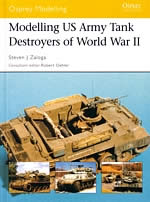 This
is another helpful book from the tireless Steve Zaloga, who kicks off the show
with an overview of U.S. tank destroyers in both 1/35 and 1/72 scales. His next
chapter, on building Academy's M36, takes a slight but welcome detour to examine
his detailing of the old Italeri M36B1, based on the M4A3 Sherman chassis. He
examines the M36 turrets from Academy, AFV Club, and Tamiya and shows how they
all are a bit out of whack. He shows the results of his build of the AFV Club
kit, and then goes on to demonstrate a winter camouflage scheme on the Academy
model. Then Zaloga makes a visit to the Braille scale M10 from Extratech, giving
it ample detailing and figures. On the more advanced skill level, he presents
AFV Club's M18 Hellcat, with comparisons to Academy's kit (he prefers the former).
Again, we're given a lot of step-by-step detailing, including some figure conversions
for the cramped turret. Finally, he demonstrates an impressive reworking of the
AFV Club M18 hull into an M39 armored utility vehicle, which was the prime mover
for the M5 3" anti-tank gun. The book is full of sharp color photos of Zaloga's
handiwork (some taken from extensive articles featured in past issues of Military
Modelling), and a color reference chart, that, relying on the fidelity of the
printer's ink, gives the actual shades of olive drab "suitable" for
various scales, with black camouflage, and weathered. This
is another helpful book from the tireless Steve Zaloga, who kicks off the show
with an overview of U.S. tank destroyers in both 1/35 and 1/72 scales. His next
chapter, on building Academy's M36, takes a slight but welcome detour to examine
his detailing of the old Italeri M36B1, based on the M4A3 Sherman chassis. He
examines the M36 turrets from Academy, AFV Club, and Tamiya and shows how they
all are a bit out of whack. He shows the results of his build of the AFV Club
kit, and then goes on to demonstrate a winter camouflage scheme on the Academy
model. Then Zaloga makes a visit to the Braille scale M10 from Extratech, giving
it ample detailing and figures. On the more advanced skill level, he presents
AFV Club's M18 Hellcat, with comparisons to Academy's kit (he prefers the former).
Again, we're given a lot of step-by-step detailing, including some figure conversions
for the cramped turret. Finally, he demonstrates an impressive reworking of the
AFV Club M18 hull into an M39 armored utility vehicle, which was the prime mover
for the M5 3" anti-tank gun. The book is full of sharp color photos of Zaloga's
handiwork (some taken from extensive articles featured in past issues of Military
Modelling), and a color reference chart, that, relying on the fidelity of the
printer's ink, gives the actual shades of olive drab "suitable" for
various scales, with black camouflage, and weathered.
Modelers
Guide to the Sherman, by Pete Harlem, Ampersand Publishing, 1999, (no
ISBN) ($20) 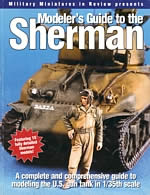 This
is a top-notch book for Shermaholics from the publishers of Military Miniatures
in Review magazine. Professing to be a "complete and comprehensive guide
to modeling the U.S. gun tank in 1/35 scale" is, frankly, a bit of a stretch.
It does offer good detail photos of some of the distinguishing characteristics
between Sherman variants, and reprints Pete Harlem's MMIR close-up articles on
tracks, suspensions, transmission housings, glacis hulls, and hull and engine
decks with remarkable illustrations. But a similar treatment of turret differences
is woefully missing, and the resource list of models, aftermarket accessories,
and references has naturally become incomplete with the passage of time—you
won't find any mention of the fine detailing sets from Formations and Tiger Model
Designs, for example. Still, a ton of information is packed into this 120 page
book, including color plates of late WWII and Korean War tanks. About half of
the book is dedicated to black-and-white construction photos and colored images
of completed models of these particular tanks: This
is a top-notch book for Shermaholics from the publishers of Military Miniatures
in Review magazine. Professing to be a "complete and comprehensive guide
to modeling the U.S. gun tank in 1/35 scale" is, frankly, a bit of a stretch.
It does offer good detail photos of some of the distinguishing characteristics
between Sherman variants, and reprints Pete Harlem's MMIR close-up articles on
tracks, suspensions, transmission housings, glacis hulls, and hull and engine
decks with remarkable illustrations. But a similar treatment of turret differences
is woefully missing, and the resource list of models, aftermarket accessories,
and references has naturally become incomplete with the passage of time—you
won't find any mention of the fine detailing sets from Formations and Tiger Model
Designs, for example. Still, a ton of information is packed into this 120 page
book, including color plates of late WWII and Korean War tanks. About half of
the book is dedicated to black-and-white construction photos and colored images
of completed models of these particular tanks:
- M4
75mm Dry Remanufactured, 756th Tank Battalion, Cassino, 1944
- M4
75mm Dry Composite Hull, 44th Tank Battalion, Philippines, 1945
- M4A1
75mm Dry, 13th Armored Regiment, Tunisia, 1943
- M4A1
75mm Dry Remanufactured with Deep Wading Gear, 754th Tank Battalion, Manila, 1945
- M4A1
76mm Wet, 3rd Armored Division, Normandy, 1944
- M4A2
75mm Dry, USMC 1st Tank Battalion, Tarawa, 1943
- M4A2
75mm Wet 47° Hull, USMC 3rd Tank Battalion, Iwo Jima, 1945
- M4A3
75mm Dry, 19th Tank Battalion, Ft. Knox, 1943
- M4A3
75mm Wet, 7th Armored Division, Belgium, 1945
- M4A3
76mm Wet, 752nd Tank Battalion, Italy, 1945
- M4A3
76mm Wet HVSS "Expedient Jumbo," 11th Armored Division, Germany, 1945
- M4A3E2
Jumbo, 4th Armored Division, Germany, 1945
- M4A4
75mm Dry, 14th Armored Division, Ft. Chaffee, 1944
- M4A4
75mm Dry Remanufactured, 1st (Provisional) Tank Battalion, Burma, 1945
- M4A6
75mm Dry, 777th Tank Battalion, Ft. Knox, 1944
This
book has been out of print for some time and even though it's far from complete,
it is still eagerly sought out by modelers. An updated version from Ampersand
is in the works and keenly awaited by many modelers, including yours truly. -tss- |













 I've been fortunate to see this impressive tank in person. Fellow Minnesota resident Bob Steinbrunn brought it to a meeting of the Minnesota Military Figure Society and again to our
I've been fortunate to see this impressive tank in person. Fellow Minnesota resident Bob Steinbrunn brought it to a meeting of the Minnesota Military Figure Society and again to our  Unlike
Zaloga's other project-oriented books below, this convenient spiral-bound tome
is a comprehensive master class in armor modeling, drawing upon an array of U.S.
armor he's built over the past two decades. Like his predecessors Shep Paine and
Tony Greenland in this approach, Zaloga provides countless tips and helpful illustrations
to walk the reader through building and improving models. From kit construction,
detailing, painting and weathering through building a base and photographing the
finished project, "The Zaloga Way" is clearly presented and will engage
beginners and advanced modelers alike. In fact, if you're fairly new to modeling
and know you want to build a range of American WWII armor, I'd recommend this
book above any other model construction books as a first purchase. Then, if you
want to go deeper into Shermans, Stuarts, and tank destroyers, you may benefit
from the books below. (Perhaps we'll see a book on building jeeps someday??)
Unlike
Zaloga's other project-oriented books below, this convenient spiral-bound tome
is a comprehensive master class in armor modeling, drawing upon an array of U.S.
armor he's built over the past two decades. Like his predecessors Shep Paine and
Tony Greenland in this approach, Zaloga provides countless tips and helpful illustrations
to walk the reader through building and improving models. From kit construction,
detailing, painting and weathering through building a base and photographing the
finished project, "The Zaloga Way" is clearly presented and will engage
beginners and advanced modelers alike. In fact, if you're fairly new to modeling
and know you want to build a range of American WWII armor, I'd recommend this
book above any other model construction books as a first purchase. Then, if you
want to go deeper into Shermans, Stuarts, and tank destroyers, you may benefit
from the books below. (Perhaps we'll see a book on building jeeps someday??) These
little light tanks were employed by all the major allies during WWII, and with
the release of M3 variants from AFV Club and Academy to complement (if not fully
supersede) Tamiya's weak M3, truncated M5A1, and creaky M8 howitzer, this book
should have wide appeal. Zaloga gives a brief overview of available light tanks
before building AFV Club's M3A3 under the French flag. This build is more out-of-the-box,
with an emphasis on painting and weathering for a Paris liberation setting. An
advanced project combines Tamiya's M3 and Academy's M3A1 kits to offer a Russian
version from 1943. This includes some reworking of the rear hull and engine grill.
We get to the Americans in a few different workings of Tamiya's M5A1, with much
more extensive corrections to the kit's too-short upper and lower hull. In the
final section, Zaloga gives some good instructions for a British M3 Honey in Northern
Africa, a Philippines M3 in 1941, a U.S. M3A1 and M5 in Tunisia, a Yugoslav M3A3
hull with a PaK 40 gun mounted in place of the turret, and a quick review of his
M8 howitzer motor carriage initially published in Military Modelling. The book
concludes with a color chart that includes "normal," "scale,"
and "faded" olive drab paints, as well as British paint colors (presumably
"normal" as the other gradients are not offered). As with all of Zaloga's
work, any AFV modeler should find ample inspiration and a good education in this
book.
These
little light tanks were employed by all the major allies during WWII, and with
the release of M3 variants from AFV Club and Academy to complement (if not fully
supersede) Tamiya's weak M3, truncated M5A1, and creaky M8 howitzer, this book
should have wide appeal. Zaloga gives a brief overview of available light tanks
before building AFV Club's M3A3 under the French flag. This build is more out-of-the-box,
with an emphasis on painting and weathering for a Paris liberation setting. An
advanced project combines Tamiya's M3 and Academy's M3A1 kits to offer a Russian
version from 1943. This includes some reworking of the rear hull and engine grill.
We get to the Americans in a few different workings of Tamiya's M5A1, with much
more extensive corrections to the kit's too-short upper and lower hull. In the
final section, Zaloga gives some good instructions for a British M3 Honey in Northern
Africa, a Philippines M3 in 1941, a U.S. M3A1 and M5 in Tunisia, a Yugoslav M3A3
hull with a PaK 40 gun mounted in place of the turret, and a quick review of his
M8 howitzer motor carriage initially published in Military Modelling. The book
concludes with a color chart that includes "normal," "scale,"
and "faded" olive drab paints, as well as British paint colors (presumably
"normal" as the other gradients are not offered). As with all of Zaloga's
work, any AFV modeler should find ample inspiration and a good education in this
book. Zaloga
does it again. This time, he walks us down Sherman memory lane with notable kits,
beginning with the workhorse M4A3 kit from Tamiya in 1981 up through the company's
recent 1/48 offerings, with visits to Italeri and DML along the way. Then he gets
into the meat of the book. The first of four featured projects is an early M4A1
from Operation Husky in Sicily, using a combination of Formations, DML, Tamiya,
and Tasca parts and RHPS tracks. Very helpfully, Zaloga provides a pattern for
the distinctive mushroom-topped wading stack used on these invasion tanks. The
next project is more advanced, correcting some upper hull deficiencies in Tamiya's
M4 and adding other aftermarket pieces and Warriors figures to portray the familiar
photo of a crew from the 8th Tank Battalion, 4th Armored Division, blasting away
with the .50 atop the tank heavily festooned with camo foliage. This projects
gets a pretty detailed interior beneath all the shrubbery. If you like mine rollers
in 1/48 scale, the following project uses Tamiya's quarter-scale M4 and Gasoline's
T1E3 mixed media mine-roller set. Zaloga provides a few tech manual illustrations
to help navigate the construction. Our final Sherman is a Dragon M4A3(76mm)W hosting
Italeri's high-bustle turret and a lot of epoxy putty for some heavy-duty glacis
sandbagging and dowel logs hung from the hull sides. The tank is then wrapped
with camo netting and topped with some scale pine boughs. Throughout the book
the writing is clear and the photos are helpful and inspiring. The book concludes
with a color chart and list of references—including a citation for the "handy
site" you are now visiting.
Zaloga
does it again. This time, he walks us down Sherman memory lane with notable kits,
beginning with the workhorse M4A3 kit from Tamiya in 1981 up through the company's
recent 1/48 offerings, with visits to Italeri and DML along the way. Then he gets
into the meat of the book. The first of four featured projects is an early M4A1
from Operation Husky in Sicily, using a combination of Formations, DML, Tamiya,
and Tasca parts and RHPS tracks. Very helpfully, Zaloga provides a pattern for
the distinctive mushroom-topped wading stack used on these invasion tanks. The
next project is more advanced, correcting some upper hull deficiencies in Tamiya's
M4 and adding other aftermarket pieces and Warriors figures to portray the familiar
photo of a crew from the 8th Tank Battalion, 4th Armored Division, blasting away
with the .50 atop the tank heavily festooned with camo foliage. This projects
gets a pretty detailed interior beneath all the shrubbery. If you like mine rollers
in 1/48 scale, the following project uses Tamiya's quarter-scale M4 and Gasoline's
T1E3 mixed media mine-roller set. Zaloga provides a few tech manual illustrations
to help navigate the construction. Our final Sherman is a Dragon M4A3(76mm)W hosting
Italeri's high-bustle turret and a lot of epoxy putty for some heavy-duty glacis
sandbagging and dowel logs hung from the hull sides. The tank is then wrapped
with camo netting and topped with some scale pine boughs. Throughout the book
the writing is clear and the photos are helpful and inspiring. The book concludes
with a color chart and list of references—including a citation for the "handy
site" you are now visiting. This
is another helpful book from the tireless Steve Zaloga, who kicks off the show
with an overview of U.S. tank destroyers in both 1/35 and 1/72 scales. His next
chapter, on building Academy's M36, takes a slight but welcome detour to examine
his detailing of the old Italeri M36B1, based on the M4A3 Sherman chassis. He
examines the M36 turrets from Academy, AFV Club, and Tamiya and shows how they
all are a bit out of whack. He shows the results of his build of the AFV Club
kit, and then goes on to demonstrate a winter camouflage scheme on the Academy
model. Then Zaloga makes a visit to the Braille scale M10 from Extratech, giving
it ample detailing and figures. On the more advanced skill level, he presents
AFV Club's M18 Hellcat, with comparisons to Academy's kit (he prefers the former).
Again, we're given a lot of step-by-step detailing, including some figure conversions
for the cramped turret. Finally, he demonstrates an impressive reworking of the
AFV Club M18 hull into an M39 armored utility vehicle, which was the prime mover
for the M5 3" anti-tank gun. The book is full of sharp color photos of Zaloga's
handiwork (some taken from extensive articles featured in past issues of Military
Modelling), and a color reference chart, that, relying on the fidelity of the
printer's ink, gives the actual shades of olive drab "suitable" for
various scales, with black camouflage, and weathered.
This
is another helpful book from the tireless Steve Zaloga, who kicks off the show
with an overview of U.S. tank destroyers in both 1/35 and 1/72 scales. His next
chapter, on building Academy's M36, takes a slight but welcome detour to examine
his detailing of the old Italeri M36B1, based on the M4A3 Sherman chassis. He
examines the M36 turrets from Academy, AFV Club, and Tamiya and shows how they
all are a bit out of whack. He shows the results of his build of the AFV Club
kit, and then goes on to demonstrate a winter camouflage scheme on the Academy
model. Then Zaloga makes a visit to the Braille scale M10 from Extratech, giving
it ample detailing and figures. On the more advanced skill level, he presents
AFV Club's M18 Hellcat, with comparisons to Academy's kit (he prefers the former).
Again, we're given a lot of step-by-step detailing, including some figure conversions
for the cramped turret. Finally, he demonstrates an impressive reworking of the
AFV Club M18 hull into an M39 armored utility vehicle, which was the prime mover
for the M5 3" anti-tank gun. The book is full of sharp color photos of Zaloga's
handiwork (some taken from extensive articles featured in past issues of Military
Modelling), and a color reference chart, that, relying on the fidelity of the
printer's ink, gives the actual shades of olive drab "suitable" for
various scales, with black camouflage, and weathered. This
is a top-notch book for Shermaholics from the publishers of Military Miniatures
in Review magazine. Professing to be a "complete and comprehensive guide
to modeling the U.S. gun tank in 1/35 scale" is, frankly, a bit of a stretch.
It does offer good detail photos of some of the distinguishing characteristics
between Sherman variants, and reprints Pete Harlem's MMIR close-up articles on
tracks, suspensions, transmission housings, glacis hulls, and hull and engine
decks with remarkable illustrations. But a similar treatment of turret differences
is woefully missing, and the resource list of models, aftermarket accessories,
and references has naturally become incomplete with the passage of time—you
won't find any mention of the fine detailing sets from Formations and Tiger Model
Designs, for example. Still, a ton of information is packed into this 120 page
book, including color plates of late WWII and Korean War tanks. About half of
the book is dedicated to black-and-white construction photos and colored images
of completed models of these particular tanks:
This
is a top-notch book for Shermaholics from the publishers of Military Miniatures
in Review magazine. Professing to be a "complete and comprehensive guide
to modeling the U.S. gun tank in 1/35 scale" is, frankly, a bit of a stretch.
It does offer good detail photos of some of the distinguishing characteristics
between Sherman variants, and reprints Pete Harlem's MMIR close-up articles on
tracks, suspensions, transmission housings, glacis hulls, and hull and engine
decks with remarkable illustrations. But a similar treatment of turret differences
is woefully missing, and the resource list of models, aftermarket accessories,
and references has naturally become incomplete with the passage of time—you
won't find any mention of the fine detailing sets from Formations and Tiger Model
Designs, for example. Still, a ton of information is packed into this 120 page
book, including color plates of late WWII and Korean War tanks. About half of
the book is dedicated to black-and-white construction photos and colored images
of completed models of these particular tanks: